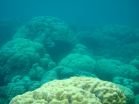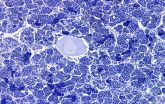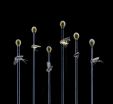(Press-News.org) By combining observations from the Japan-led Suzaku X-ray satellite and the European Space Agency's infrared Herschel Space Observatory, scientists have connected a fierce "wind" produced near a galaxy's monster black hole to an outward torrent of cold gas a thousand light-years across. The finding validates a long-suspected feedback mechanism enabling a supermassive black hole to influence the evolution of its host galaxy.
"This is the first study directly connecting a galaxy's actively 'feeding' black hole to features found at much larger physical scales," said lead researcher Francesco Tombesi, an astrophysicist at NASA's Goddard Space Flight Center in Greenbelt, Maryland, and the University of Maryland, College Park (UMCP). "We detect the wind arising from the luminous disk of gas very close to the black hole, and we show that it's responsible for blowing star-forming gas out of the galaxy's central regions."
Star formation takes place in cold, dense molecular clouds. By heating and dispersing gas that could one day make stars, the black-hole wind forever alters a large portion of its galaxy.
In a study published in the March 26 edition of Nature, Tombesi and his team report the connection in a galaxy known as IRAS F11119+3257, or F11119 for short. The galaxy is so distant, its light has been traveling to us for 2.3 billion years, or about half the present age of our solar system.
Like most galaxies, including our own Milky Way, F11119 hosts a supersized black hole, one estimated at 16 million times the sun's mass. The black hole's activity is fueled by a rotating collection of gas called an accretion disk, which is some hundreds of times the size of our planetary system. Closest to the black hole, the orbiting matter reaches temperatures of millions of degrees and is largely responsible for the galaxy's enormous energy output, which exceeds the sun's by more than a trillion times. The galaxy is heavily enshrouded by dust, so most of this emission reaches us in the form of infrared light
The new findings resolve a long-standing puzzle. Galaxies show a correlation between the mass of their central black holes and stellar properties across a much larger region called the galactic bulge. Galaxies with more massive black holes usually possess bulges with proportionately greater stellar mass and faster-moving stars.
Black holes grow the same way their host galaxies do, by colliding and merging with their neighbors. But mergers disrupt galaxies, which leads to greatly enhanced star formation and sends a flood of gas toward the merged black hole. The process should scramble any simple relationship between the black hole's growth and the galaxy's evolution, yet it doesn't.
"These connections suggested the black hole was providing some form of feedback that modulated star formation in the wider galaxy, but it was difficult to see how," said team member Sylvain Veilleux, an astronomy professor at UMCP. "With the discovery of powerful molecular outflows of cold gas in galaxies with active black holes, we began to uncover the connection."
In 2013, Veilleux led a search for these outflows in a sample of active galaxies using the Herschel Space Observatory. In F11119, the researchers identified a strong outflow of hydroxyl molecules moving at about 2 million mph (3 million kph). Other studies using different trace molecules found similar flows.
In the present study, Tombesi, Veilleux and their colleagues estimate that this outflow operates up to 1,000 light-years from the galaxy's center and calculate that it removes enough gas to make 800 copies of our sun.
In May 2013, the team observed F11119 using Suzaku's X-ray Imaging Spectrometer, obtaining an effective exposure of nearly three days. The galaxy's spectrum indicates that X-ray-absorbing gas is racing outward from the innermost accretion disk at 170 million mph (270 million kph), or about a quarter the speed of light. The region is possibly half a billion miles (800 million km) from the brink of the black hole, and about as close to the point where not even light can escape as Jupiter is from the sun.
"The black hole is ingesting gas as fast as it can and is tremendously heating the accretion disk, allowing it to produce about 80 percent of the energy this galaxy emits," said co-author Marcio Meléndez, a research associate at UMCP. "But the disk is so luminous some of the gas accelerates away from it, creating the X-ray wind we observe."
Taken together, the disk wind and the molecular outflow complete the picture of black-hole feedback. The black-hole wind sets cold gas and dust into motion, giving rise to the molecular outflow. It also heats dust enshrouding the galaxy, leading to the formation of an outward-moving shock wave that sweeps away additional gas and dust.
When the black hole shines at its brightest, the researchers say, it's also effectively pushing away the dinner plate, clearing gas and dust from the galaxy's central regions and shutting down star formation there. Once the dust has been cleared out, shorter-wavelength light from the disk can escape more easily.
Scientists think ultra-luminous infrared galaxies like F11119 represent an early phase in the evolution of quasars, a type of black-hole-powered galaxy with extreme luminosity across a broad wavelength range. According to this picture, the black hole will eventually consume its surrounding gas and gradually end its spectacular activity. As it does so, it will evolve from a quasar to a gas-poor galaxy with a relatively low level of star formation.
INFORMATION:
The researchers hope to detect and study this process in other galaxies and look forward to the improved sensitivity of Suzaku's successor, ASTRO-H. Expected to launch in 2016, ASTRO-H is being developed at the Institute of Space and Astronautical Science of the Japan Aerospace Exploration Agency (ISAS/JAXA), in collaboration with NASA Goddard and Japanese institutions.
The American Gastroenterological Association (AGA) has released new guidelines on the management of asymptomatic neoplastic pancreatic cysts found incidentally during computed tomography (CT) or magnetic resonance imaging (MRI). The author of a commentary being published in Annals of Internal Medicine explains how the AGA's bold new recommendations will affect the way physicians consider diagnostic testing. The new guidelines back away from previous recommendations that were more aggressive. Rather than promote invasive work-up, surveillance, or surgery for typical patients, ...
After six years of painstaking research, a UCLA-led team has validated the first standardized protocol for measuring one of the earliest signs of Alzheimer's disease -- the atrophy of the part of the brain known as the hippocampus.
The finding marks the final step in an international consortium's successful effort to develop a unified and reliable approach to assessing signs of Alzheimer's-related neurodegeneration through structural imaging tests, a staple in the diagnosis and monitoring of the disease. The study is published in the journal Alzheimer's and Dementia.
Using ...
MELBOURNE, FLA. -- Reef-building corals, already thought to be living near their upper thermal limits, are experiencing unprecedented declines as the world's oceans continue to warm. New evidence from scientists at Florida Institute of Technology shows there may be some climate refuges where corals will survive in the future.
The study appears in the March issue of Global Change Biology.
Ph.D. student Chris Cacciapaglia and his advisor, Robert van Woesik, hypothesized that not all regions of the oceans are warming at the same rate.
"The idea was to identify regions ...
Tracking the rotation speed of solid planets, like the Earth and Mars, is a relatively simple task: Just measure the time it takes for a surface feature to roll into view again. But giant gas planets Jupiter and Saturn are more problematic for planetary scientists, as they both lack measureable solid surfaces and are covered by thick layers of clouds, foiling direct visual measurements by space probes. Saturn has presented an even greater challenge to scientists, as different parts of this sweltering ball of hydrogen and helium are known to rotate at different speeds, whereas ...
(New York - March 25, 2015) Induced pluripotent stem cells (iPSCs) -- adult cells reprogrammed back to an embryonic stem cell-like state--may better model the genetic contributions to each patient's particular disease. In a process called cellular reprogramming, researchers at Icahn School of Medicine at Mount Sinai have taken mature blood cells from patients with myelodysplastic syndrome (MDS) and reprogrammed them back into iPSCs to study the genetic origins of this rare blood cancer. The results appear in an upcoming issue of Nature Biotechnology.
In MDS, genetic mutations ...
CORVALLIS, Ore. - Deep-water marine fish living on the continental slopes at depths from 2,000 feet to one mile have liver pathologies, tumors and other health problems that may be linked to human-caused pollution, one of the first studies of its type has found.
The research, conducted in the Bay of Biscay west of France, also discovered the first case of a deep water fish species with an "intersex" condition, a blend of male and female sex organs. The sampling was done in an area with no apparent point-source pollution, and appears to reflect general ocean conditions.
The ...
DURHAM, N.C. -- The value of many oceanfront properties on the East Coast could drop dramatically if Congress were to suddenly end federal beach nourishment subsidies, a new study by researchers at three universities finds.
In beach nourishment, new sand, often dredged from nearby inlets or the offshore sea floor, is added to an eroding beach to widen it and help prevent future erosion.
"The expectation that the federal government will continue to provide subsidies for erosion-control measures has significantly inflated property values in many coastal communities," ...
Would-be participants of higher education must be given full and transparent advice before they accumulate debts as students that follow them into the workplace, according to a report published in the International Journal of Pluralism and Economics Education.
Deborah Figart of the School of Education, at The Richard Stockton College of New Jersey in Galloway, says that there is a dearth of pre-loan and post-loan counseling for undergraduate students using student loans to help finance their higher education. She has devised an assignment that can be adapted to a wide ...
A new paper to be published in the journal Zootaxa (April 6, 2015) describes 30 new insect species in a single genus, Megaselia, of the fly family Phoridae. Describing 30 species in a single paper is rare, but what's especially striking is that all these come from urban Los Angeles.
The discoveries come from researchers in the BioSCAN project (Biodiversity Science: City and Nature) at the Natural History Museum of Los Angeles County (NHM). The BioSCAN project is a three year investigation of patterns of biodiversity in and around urban Los Angeles, based on sampling ...
AUBURN, AL - In the production of organic vegetables, nitrogen is important, yet can be quite costly to manage. Nitrogen management is even more challenging when production practices call for the use of polyethylene mulch combined with fertigation. The authors of a new study published in HortScience have found that hydrolyzed fish fertilizer holds promise as an "economically feasible" nitrogen source for growing organic vegetables.
"Soluble organic nitrogen sources suitable for fertigation in organic vegetable production are much needed," said lead author of the study, ...



